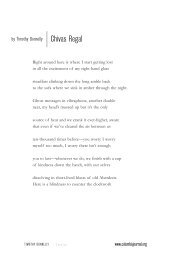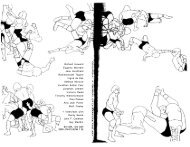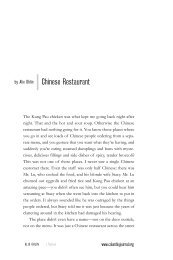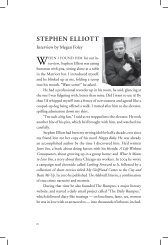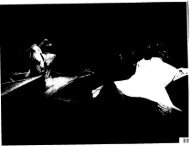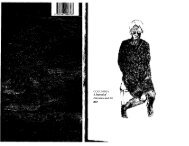Issue 27 - Columbia: A Journal of Literature and Art
Issue 27 - Columbia: A Journal of Literature and Art
Issue 27 - Columbia: A Journal of Literature and Art
You also want an ePaper? Increase the reach of your titles
YUMPU automatically turns print PDFs into web optimized ePapers that Google loves.
IOO<br />
a sensational way. The work there seems a bit sensational, or<br />
hysterical. That might not be entirely fair. Use <strong>of</strong> materials may<br />
be a bit on the wane, there may be a return to painting now. But<br />
here, it seems a little more authentic to me, more interior. People<br />
here are in their studios working away, like in a vacuum. There's<br />
a return to painting.<br />
C: You're planning an exchange with the Linton Griffin gallery in<br />
California. How do you predict that work will be perceived on<br />
opposite coasts?<br />
BK: There's a painter I'd like to show, Daniel Manns, whose work<br />
is very Californian, in a way. It's very bright <strong>and</strong> sun-drenched.<br />
The palette in New York is pretty dark, generally.<br />
C: Will the difference be obvious here, showing Californian<br />
work?<br />
BK: There are artists who just haven't been seen here, <strong>and</strong> I want<br />
to show them. Tom LaDuke uses such mundane things, like an<br />
antenna. There's something really poetic about his work: to pick<br />
things from everyday life that you might just look at <strong>and</strong> say how<br />
Untitled, Michael Ashkin<br />
COURTESY OF BRONWYN KEENAN GALLERY, NEW YORK<br />
boring, but he has this passing through sense <strong>of</strong> things, about how<br />
everything looks the same after awhile; he just sort <strong>of</strong> isolates these<br />
things <strong>and</strong> makes them look like something else.<br />
C: How will they perceive New York work in California?<br />
BK: I think the community is so much smaller out there, in terms<br />
<strong>of</strong> galleries or number <strong>of</strong> artists who live out there full time, that<br />
they'll welcome the work, to see something new.<br />
COLUMBIA: What are the major differences between East <strong>and</strong> West?<br />
Meg Linton: After living in New York for four months, I found<br />
the only difference between the cities is density. What New York<br />
City has compacted into eight miles is spread out all over<br />
California, but I still heard the same complaints by the New York<br />
artists I visited: "There are no young galleries showing emerging<br />
artists," or "No one is willing to take the risk," or "No one is<br />
collecting contemporary art, unless it's a proven investment." That<br />
is why Keenan is such a mecca for young artists in New York <strong>and</strong><br />
why Griffin Linton is a haven for young artists in Southern<br />
California.<br />
The biggest insight I had into New York was realizing how<br />
traditional, prejudiced (against non-New York or non-European<br />
artists) <strong>and</strong> conservative the art scene is. ... In California the art<br />
scene is very connected to the University system <strong>and</strong> people are<br />
less concerned about what something is <strong>and</strong> more concerned<br />
about the artist's intention. This is a gross generalization, but it is<br />
a strong impression I walked away with from my experience there.<br />
The New York artists we show in L.A. will receive less prejudice<br />
than will our L.A. artists exhibiting in New York. New York sees<br />
itself as the pinnacle <strong>of</strong> the art world, particularly in the marketplace.<br />
C: Tell us more about how New York artists will be received in<br />
California. What differences are notable?<br />
ML: We have had fabulous response to Michael Ashkin, Leslie<br />
Brack, Manuel Pardo <strong>and</strong> Ellen Berkenblit's work. There is a<br />
difference in the work, <strong>and</strong> it is incredibly difficult to articulate the<br />
physical or aesthetic difference, but I do believe a large factor is the<br />
difference in environment: open versus compact space, horizontal





